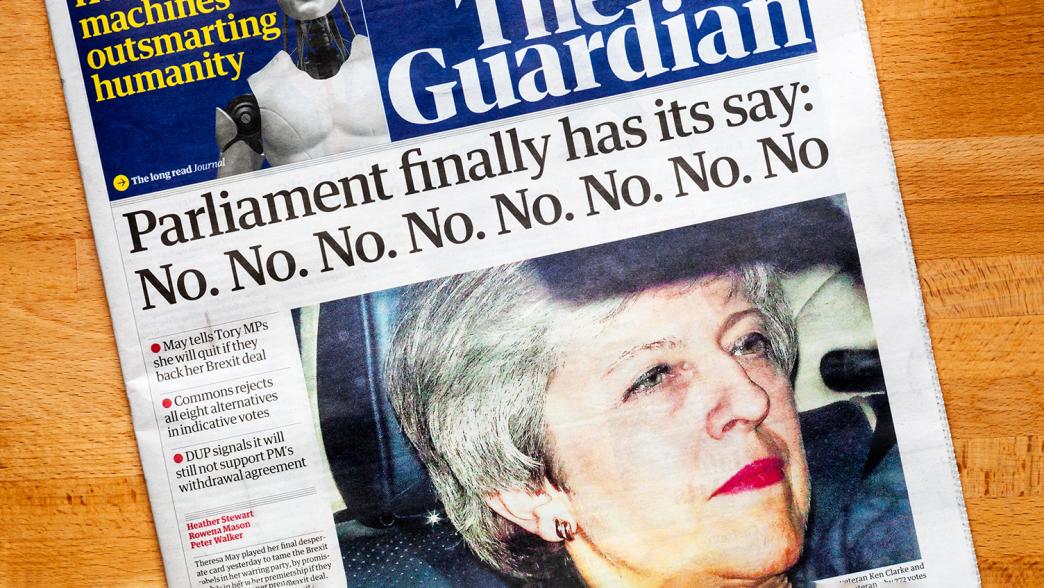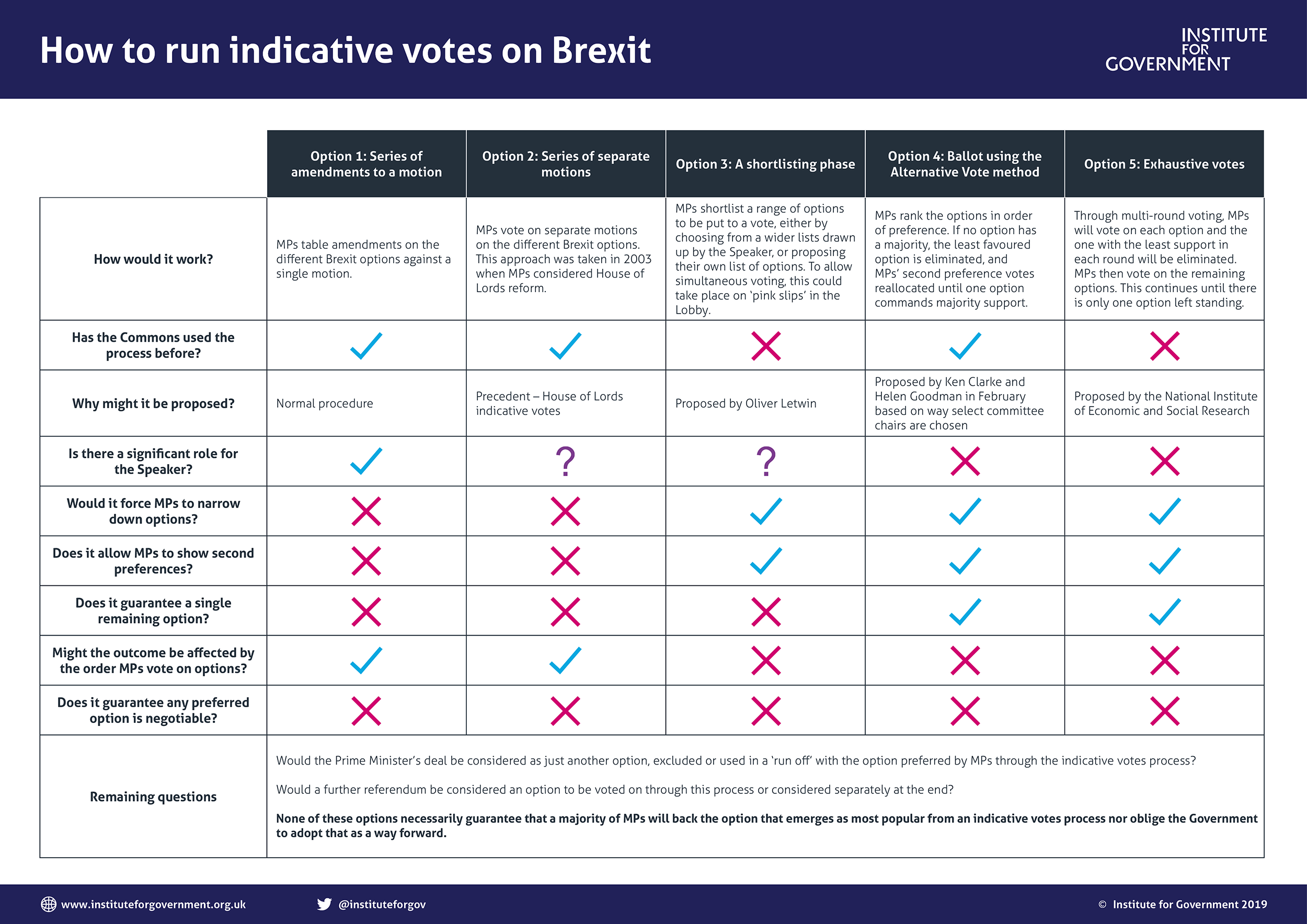Indicative votes on Brexit
Indicative votes are votes by MPs on a series of non-binding resolutions. We explain why the government allowed MPs indicative votes on Brexit.

What are indicative votes?
Indicative votes are votes by MPs on a series of non-binding resolutions. They are a means of testing the will of the House of Commons on different options relating to one issue.
Why did the government allow MPs to have an indicative vote on Brexit?
The House of Commons rejected the government’s draft deal with the EU in January 2019, by a margin of 230 votes, and again on 12 March, by a smaller margin of 149. On 29 March the government was defeated on the Withdrawal Agreement by 58 votes. This meant that parliament was at an impasse: MPs did not support the government’s proposed deal, but had also previously voted in favour of a motion which ruled out a no-deal Brexit.
In the two years since the government triggered Article 50, MPs had tabled numerous amendments to government motions and bills. While some of these had set out their preferred Brexit approach, many of the more recent amendments focused on the process of leaving the EU rather than the outcome itself. There was therefore no clarity over whether there was a sustainable majority in favour of any particular Brexit outcome.
The Exiting the European Union Committee suggested a series of indicative votes to test the sentiment of MPs and narrow down the range of options.
On 25 March MPs voted to take control of parliamentary business in order to make time to hold indicative votes on different Brexit options. Votes were held on 27 March, and while no option commanded the support of a majority of MPs, they did give an indication of where parliamentary opinion lay.
A second round of votes were held on 1 April, in an attempt to narrow down the options further, but these also failed to produce a majority for any of the options. On 3 April, MPs voted against holding a third round of indicative votes.
Who can arrange indicative votes?
Indicative votes can be proposed by either the government or MPs.
The government can choose to offer indicative votes by tabling a motion outlining the options for MPs to consider and the order in which they will be voted on (or, alternatively, a process through which the options and order could be decided on – for instance, by a committee of MPs).
MPs can also propose their own set of indicative votes, for instance by amending a motion in the Commons. Such amendments would need to be selected by the Speaker, and could provide for indicative votes in one of two ways:
- Directly, by outlining the options for MPs to consider and the order in which they will be voted on (or, alternatively, a process through which the options and order could be decided on).
- Indirectly, by voting to give MPs control of the agenda in the Commons – providing an opportunity for MPs to schedule indicative votes at a future date. Such an amendment, tabled by Sir Oliver Letwin, was approved by MPs on 25 March, by 329 votes to 302, paving the way for the indicative votes held on 27 March. The business motion also gave MPs control of parliamentary business on 1 April, and MPs then voted on another business motion which outlined the process for the second round of indicative votes on 1 April.
How does the voting process work?
Different voting methods can be used for indicative votes, and which method is chosen can impact how likely the process will reveal MPs’ preferences.
The table below illustrates the different voting methods and some of the issues they pose. Indicative votes have traditionally been run using Option 2, although there are concerns that this method would give too much discretion to the Speaker, encourage tactical voting, and fail to identify an option commanding the support of a majority in the Commons led MPs to adopt a different voting method for the indicative votes on Brexit.
As a result, the first round of Brexit indicative votes, held on 27 March, used Option 3. As Sir Oliver Letwin told MPs, this first set of votes was an attempt to identify a shortlist of options to be included in the second round of indicative votes, should no option command a majority in the first round.
It had been thought that Option 4 or 5 would be used for the second round of votes, as these methods are more likely to identify a single option commanding the support of a majority of MPs. However, in the event Option 3 was used again.
Whether the outcome of indicative votes is conclusive depends on the options selected for a vote, how parties whip their MPs to vote, the degree of tactical voting by MPs, and the voting system used.
Some have argued that the indicative votes held on Brexit would have worked better had a different voting system been used – either exhaustive voting, the alternative vote, or majority judgement.
Does the government have to accept the outcome of indicative votes?
The government is not usually bound by indicative votes, unless it has agreed to beforehand.
Have indicative votes been used as a tactic before Brexit?
In 2003, MPs were presented with seven different options for reforming the House of Lords, and were able to vote on each individual option. No option garnered a majority among MPs.
However, the 2003 votes were only advisory and did not relate to a motion giving something statutory effect (as any indicative vote prior to the meaningful vote would do). This means that there is no direct precedent for indicative votes being used in this way.
Are indicative votes whipped?
Indicative votes could be free votes for MPs of some or all parties – meaning that MPs would not be whipped and required to follow a party line. It is likely that the votes would have to be free, as was the case in 2003, if the purpose of them was to understand the views of MPs.
- Administration
- May government
- Legislature
- House of Commons
- Publisher
- Institute for Government
